Carbon Credits: An Analysis of Legal and Financial Aspects in AU
VerifiedAdded on 2023/06/13
|20
|4425
|204
Report
AI Summary
This report examines the carbon offset market, focusing on its legal framework within Australia, particularly the Corporations Act 2001. It discusses the role of carbon credits in reducing greenhouse gas emissions and promoting renewable energy use. The report covers the background and purpose of carbon credit trading, including compliance with legal provisions. It uses secondary research to analyze the effectiveness and implications of carbon credits, carbon farming initiatives and Management Information Systems (MIS) in trading and scrutinizing carbon credits. The report concludes by assessing the advantages and disadvantages of legal provisions from the perspective of various stakeholders in the Australian context.
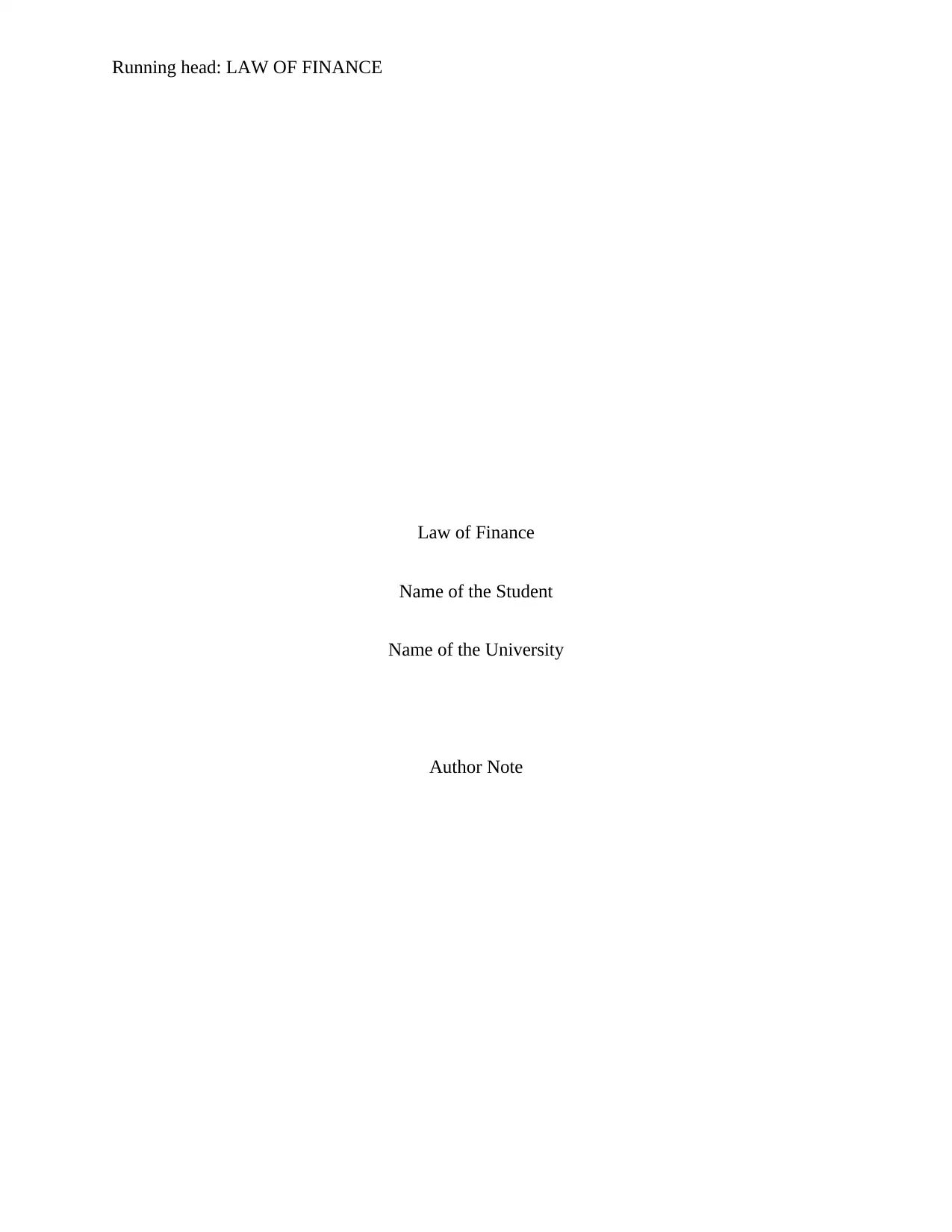
Running head: LAW OF FINANCE
Law of Finance
Name of the Student
Name of the University
Author Note
Law of Finance
Name of the Student
Name of the University
Author Note
Paraphrase This Document
Need a fresh take? Get an instant paraphrase of this document with our AI Paraphraser
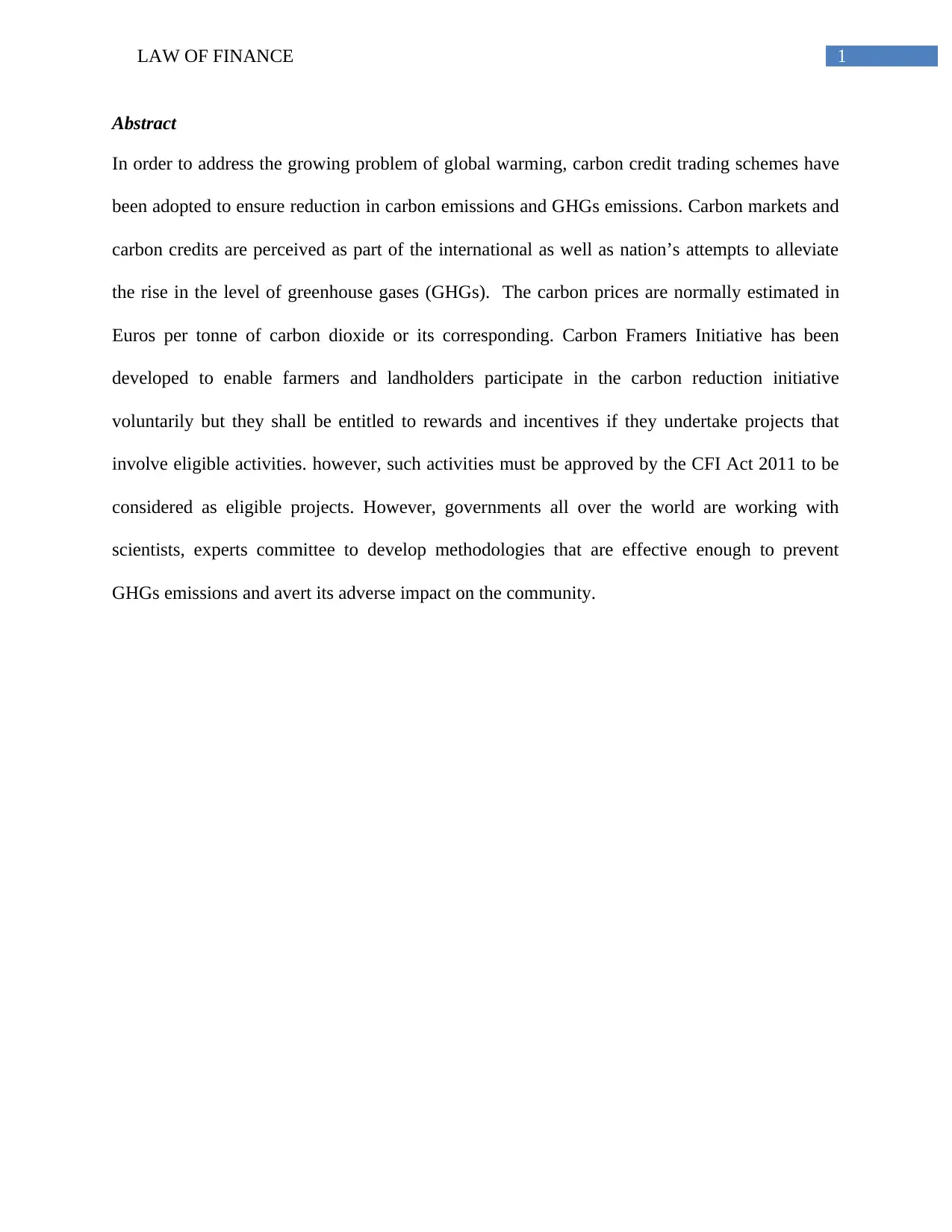
1LAW OF FINANCE
Abstract
In order to address the growing problem of global warming, carbon credit trading schemes have
been adopted to ensure reduction in carbon emissions and GHGs emissions. Carbon markets and
carbon credits are perceived as part of the international as well as nation’s attempts to alleviate
the rise in the level of greenhouse gases (GHGs). The carbon prices are normally estimated in
Euros per tonne of carbon dioxide or its corresponding. Carbon Framers Initiative has been
developed to enable farmers and landholders participate in the carbon reduction initiative
voluntarily but they shall be entitled to rewards and incentives if they undertake projects that
involve eligible activities. however, such activities must be approved by the CFI Act 2011 to be
considered as eligible projects. However, governments all over the world are working with
scientists, experts committee to develop methodologies that are effective enough to prevent
GHGs emissions and avert its adverse impact on the community.
Abstract
In order to address the growing problem of global warming, carbon credit trading schemes have
been adopted to ensure reduction in carbon emissions and GHGs emissions. Carbon markets and
carbon credits are perceived as part of the international as well as nation’s attempts to alleviate
the rise in the level of greenhouse gases (GHGs). The carbon prices are normally estimated in
Euros per tonne of carbon dioxide or its corresponding. Carbon Framers Initiative has been
developed to enable farmers and landholders participate in the carbon reduction initiative
voluntarily but they shall be entitled to rewards and incentives if they undertake projects that
involve eligible activities. however, such activities must be approved by the CFI Act 2011 to be
considered as eligible projects. However, governments all over the world are working with
scientists, experts committee to develop methodologies that are effective enough to prevent
GHGs emissions and avert its adverse impact on the community.
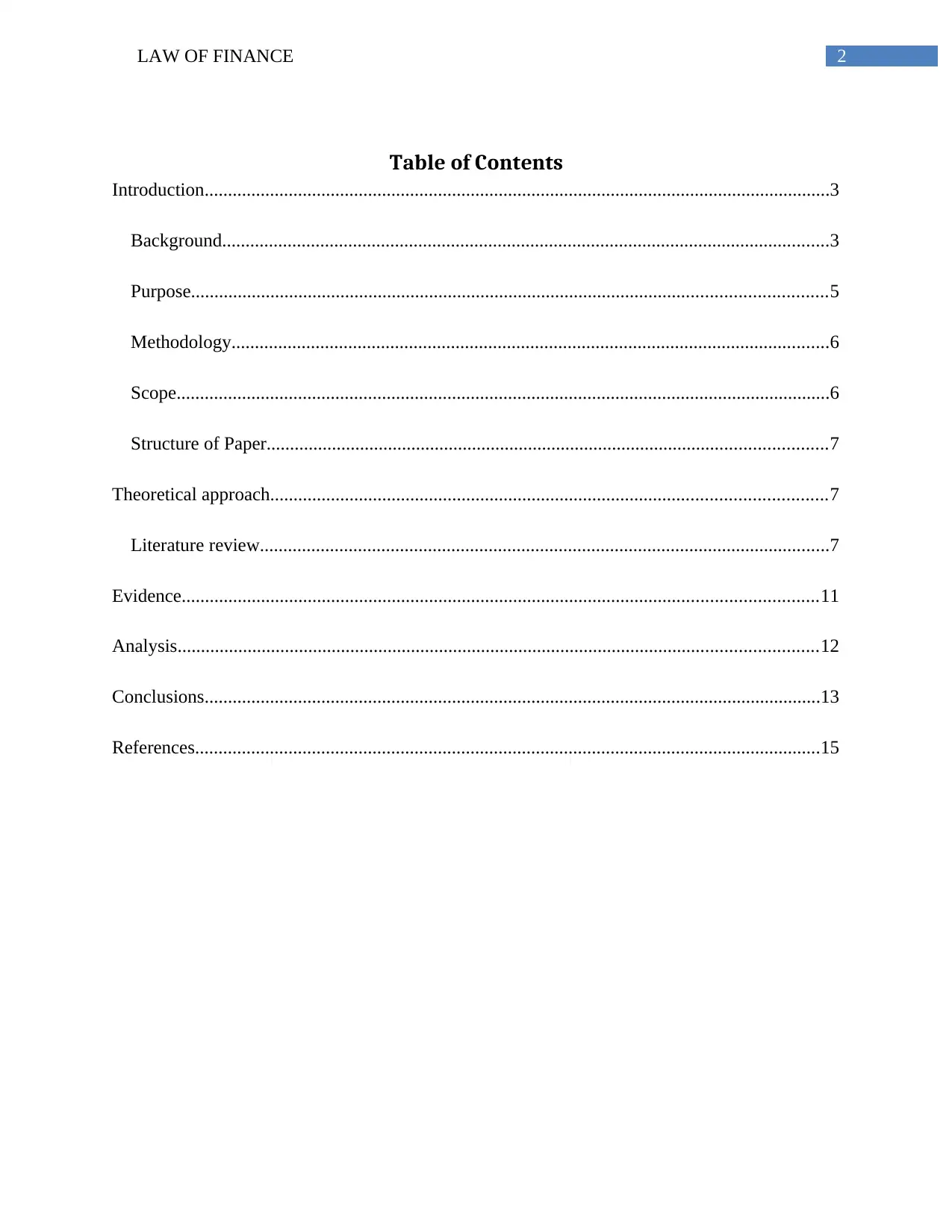
2LAW OF FINANCE
Table of Contents
Introduction......................................................................................................................................3
Background..................................................................................................................................3
Purpose........................................................................................................................................5
Methodology................................................................................................................................6
Scope............................................................................................................................................6
Structure of Paper........................................................................................................................7
Theoretical approach.......................................................................................................................7
Literature review..........................................................................................................................7
Evidence........................................................................................................................................11
Analysis.........................................................................................................................................12
Conclusions....................................................................................................................................13
References......................................................................................................................................15
Table of Contents
Introduction......................................................................................................................................3
Background..................................................................................................................................3
Purpose........................................................................................................................................5
Methodology................................................................................................................................6
Scope............................................................................................................................................6
Structure of Paper........................................................................................................................7
Theoretical approach.......................................................................................................................7
Literature review..........................................................................................................................7
Evidence........................................................................................................................................11
Analysis.........................................................................................................................................12
Conclusions....................................................................................................................................13
References......................................................................................................................................15
⊘ This is a preview!⊘
Do you want full access?
Subscribe today to unlock all pages.

Trusted by 1+ million students worldwide
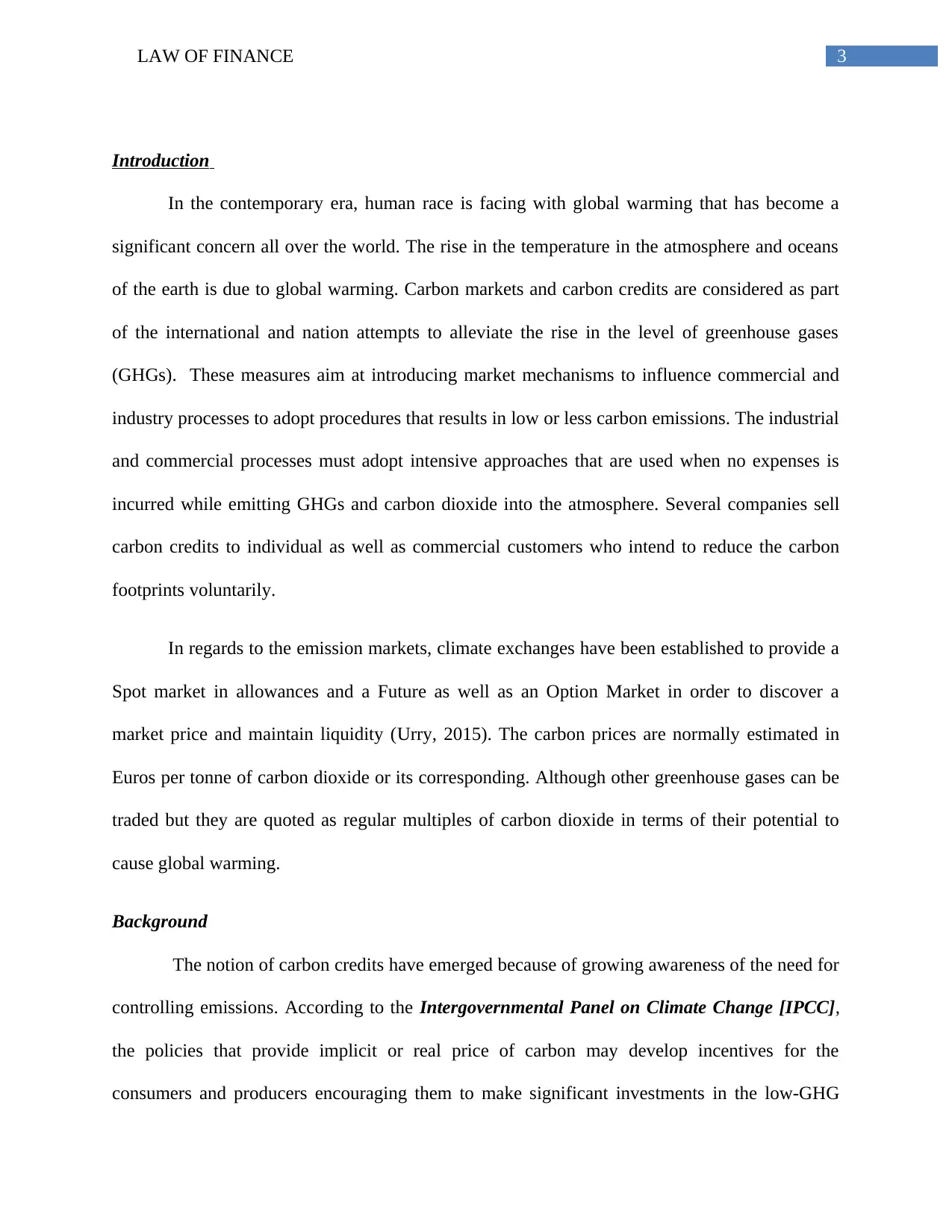
3LAW OF FINANCE
Introduction
In the contemporary era, human race is facing with global warming that has become a
significant concern all over the world. The rise in the temperature in the atmosphere and oceans
of the earth is due to global warming. Carbon markets and carbon credits are considered as part
of the international and nation attempts to alleviate the rise in the level of greenhouse gases
(GHGs). These measures aim at introducing market mechanisms to influence commercial and
industry processes to adopt procedures that results in low or less carbon emissions. The industrial
and commercial processes must adopt intensive approaches that are used when no expenses is
incurred while emitting GHGs and carbon dioxide into the atmosphere. Several companies sell
carbon credits to individual as well as commercial customers who intend to reduce the carbon
footprints voluntarily.
In regards to the emission markets, climate exchanges have been established to provide a
Spot market in allowances and a Future as well as an Option Market in order to discover a
market price and maintain liquidity (Urry, 2015). The carbon prices are normally estimated in
Euros per tonne of carbon dioxide or its corresponding. Although other greenhouse gases can be
traded but they are quoted as regular multiples of carbon dioxide in terms of their potential to
cause global warming.
Background
The notion of carbon credits have emerged because of growing awareness of the need for
controlling emissions. According to the Intergovernmental Panel on Climate Change [IPCC],
the policies that provide implicit or real price of carbon may develop incentives for the
consumers and producers encouraging them to make significant investments in the low-GHG
Introduction
In the contemporary era, human race is facing with global warming that has become a
significant concern all over the world. The rise in the temperature in the atmosphere and oceans
of the earth is due to global warming. Carbon markets and carbon credits are considered as part
of the international and nation attempts to alleviate the rise in the level of greenhouse gases
(GHGs). These measures aim at introducing market mechanisms to influence commercial and
industry processes to adopt procedures that results in low or less carbon emissions. The industrial
and commercial processes must adopt intensive approaches that are used when no expenses is
incurred while emitting GHGs and carbon dioxide into the atmosphere. Several companies sell
carbon credits to individual as well as commercial customers who intend to reduce the carbon
footprints voluntarily.
In regards to the emission markets, climate exchanges have been established to provide a
Spot market in allowances and a Future as well as an Option Market in order to discover a
market price and maintain liquidity (Urry, 2015). The carbon prices are normally estimated in
Euros per tonne of carbon dioxide or its corresponding. Although other greenhouse gases can be
traded but they are quoted as regular multiples of carbon dioxide in terms of their potential to
cause global warming.
Background
The notion of carbon credits have emerged because of growing awareness of the need for
controlling emissions. According to the Intergovernmental Panel on Climate Change [IPCC],
the policies that provide implicit or real price of carbon may develop incentives for the
consumers and producers encouraging them to make significant investments in the low-GHG
Paraphrase This Document
Need a fresh take? Get an instant paraphrase of this document with our AI Paraphraser
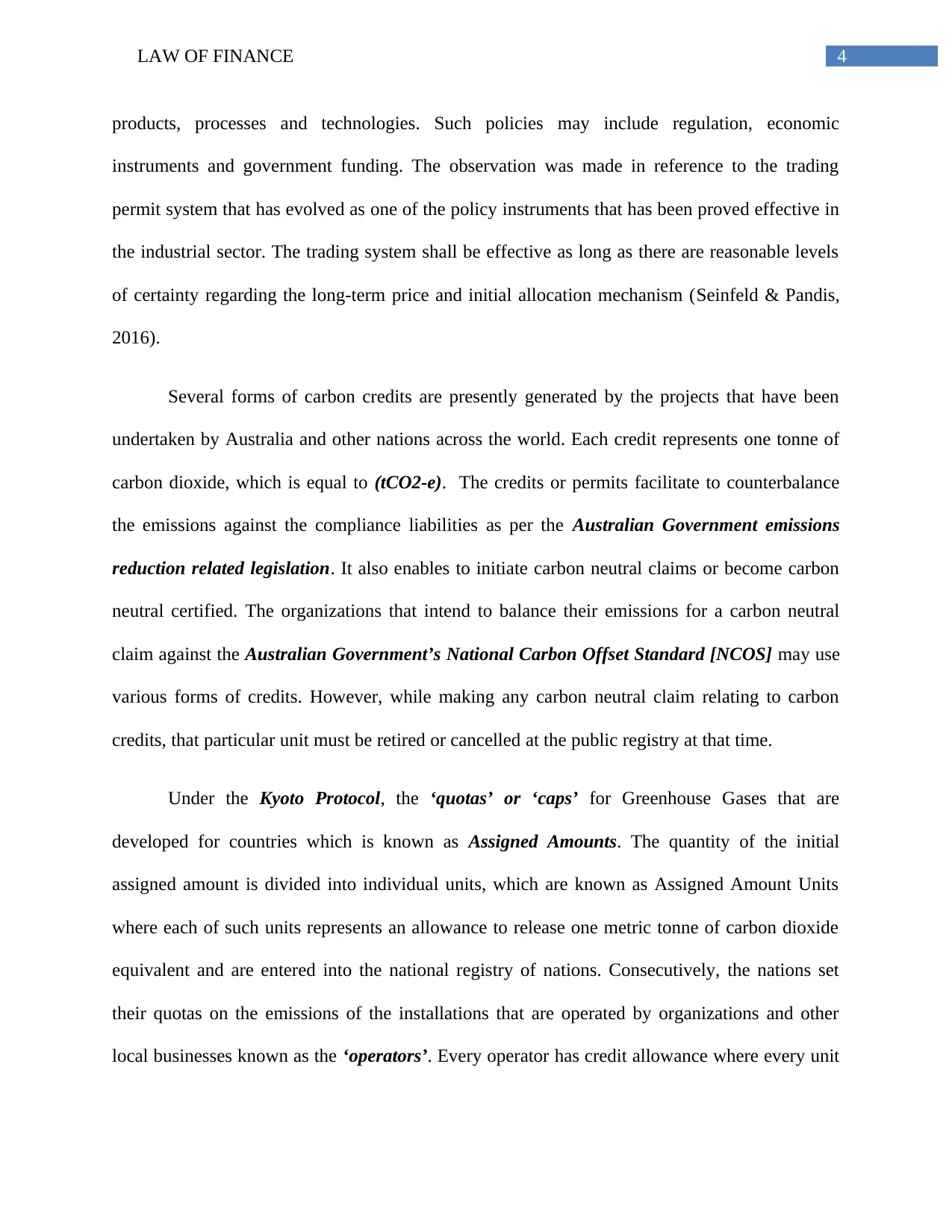
4LAW OF FINANCE
products, processes and technologies. Such policies may include regulation, economic
instruments and government funding. The observation was made in reference to the trading
permit system that has evolved as one of the policy instruments that has been proved effective in
the industrial sector. The trading system shall be effective as long as there are reasonable levels
of certainty regarding the long-term price and initial allocation mechanism (Seinfeld & Pandis,
2016).
Several forms of carbon credits are presently generated by the projects that have been
undertaken by Australia and other nations across the world. Each credit represents one tonne of
carbon dioxide, which is equal to (tCO2-e). The credits or permits facilitate to counterbalance
the emissions against the compliance liabilities as per the Australian Government emissions
reduction related legislation. It also enables to initiate carbon neutral claims or become carbon
neutral certified. The organizations that intend to balance their emissions for a carbon neutral
claim against the Australian Government’s National Carbon Offset Standard [NCOS] may use
various forms of credits. However, while making any carbon neutral claim relating to carbon
credits, that particular unit must be retired or cancelled at the public registry at that time.
Under the Kyoto Protocol, the ‘quotas’ or ‘caps’ for Greenhouse Gases that are
developed for countries which is known as Assigned Amounts. The quantity of the initial
assigned amount is divided into individual units, which are known as Assigned Amount Units
where each of such units represents an allowance to release one metric tonne of carbon dioxide
equivalent and are entered into the national registry of nations. Consecutively, the nations set
their quotas on the emissions of the installations that are operated by organizations and other
local businesses known as the ‘operators’. Every operator has credit allowance where every unit
products, processes and technologies. Such policies may include regulation, economic
instruments and government funding. The observation was made in reference to the trading
permit system that has evolved as one of the policy instruments that has been proved effective in
the industrial sector. The trading system shall be effective as long as there are reasonable levels
of certainty regarding the long-term price and initial allocation mechanism (Seinfeld & Pandis,
2016).
Several forms of carbon credits are presently generated by the projects that have been
undertaken by Australia and other nations across the world. Each credit represents one tonne of
carbon dioxide, which is equal to (tCO2-e). The credits or permits facilitate to counterbalance
the emissions against the compliance liabilities as per the Australian Government emissions
reduction related legislation. It also enables to initiate carbon neutral claims or become carbon
neutral certified. The organizations that intend to balance their emissions for a carbon neutral
claim against the Australian Government’s National Carbon Offset Standard [NCOS] may use
various forms of credits. However, while making any carbon neutral claim relating to carbon
credits, that particular unit must be retired or cancelled at the public registry at that time.
Under the Kyoto Protocol, the ‘quotas’ or ‘caps’ for Greenhouse Gases that are
developed for countries which is known as Assigned Amounts. The quantity of the initial
assigned amount is divided into individual units, which are known as Assigned Amount Units
where each of such units represents an allowance to release one metric tonne of carbon dioxide
equivalent and are entered into the national registry of nations. Consecutively, the nations set
their quotas on the emissions of the installations that are operated by organizations and other
local businesses known as the ‘operators’. Every operator has credit allowance where every unit
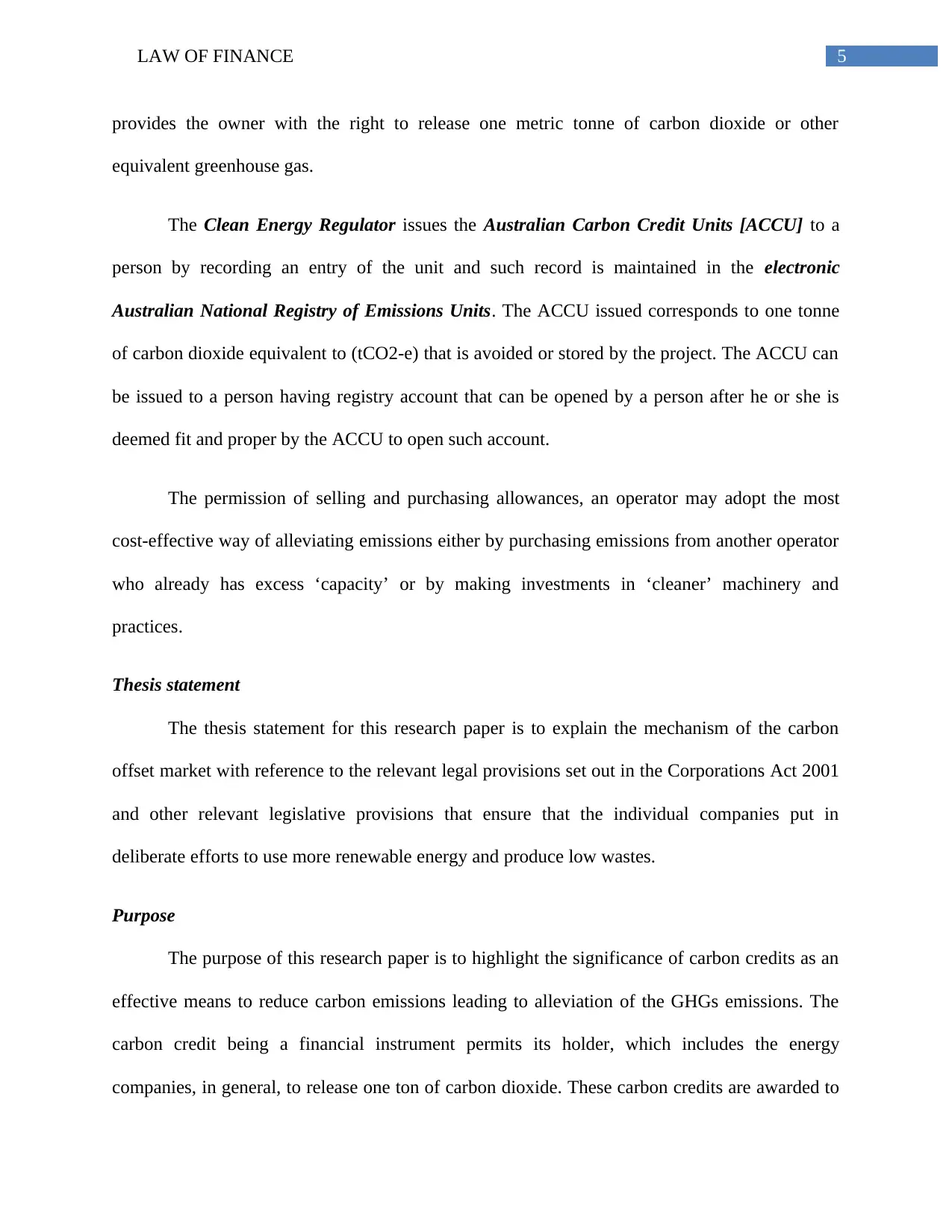
5LAW OF FINANCE
provides the owner with the right to release one metric tonne of carbon dioxide or other
equivalent greenhouse gas.
The Clean Energy Regulator issues the Australian Carbon Credit Units [ACCU] to a
person by recording an entry of the unit and such record is maintained in the electronic
Australian National Registry of Emissions Units. The ACCU issued corresponds to one tonne
of carbon dioxide equivalent to (tCO2-e) that is avoided or stored by the project. The ACCU can
be issued to a person having registry account that can be opened by a person after he or she is
deemed fit and proper by the ACCU to open such account.
The permission of selling and purchasing allowances, an operator may adopt the most
cost-effective way of alleviating emissions either by purchasing emissions from another operator
who already has excess ‘capacity’ or by making investments in ‘cleaner’ machinery and
practices.
Thesis statement
The thesis statement for this research paper is to explain the mechanism of the carbon
offset market with reference to the relevant legal provisions set out in the Corporations Act 2001
and other relevant legislative provisions that ensure that the individual companies put in
deliberate efforts to use more renewable energy and produce low wastes.
Purpose
The purpose of this research paper is to highlight the significance of carbon credits as an
effective means to reduce carbon emissions leading to alleviation of the GHGs emissions. The
carbon credit being a financial instrument permits its holder, which includes the energy
companies, in general, to release one ton of carbon dioxide. These carbon credits are awarded to
provides the owner with the right to release one metric tonne of carbon dioxide or other
equivalent greenhouse gas.
The Clean Energy Regulator issues the Australian Carbon Credit Units [ACCU] to a
person by recording an entry of the unit and such record is maintained in the electronic
Australian National Registry of Emissions Units. The ACCU issued corresponds to one tonne
of carbon dioxide equivalent to (tCO2-e) that is avoided or stored by the project. The ACCU can
be issued to a person having registry account that can be opened by a person after he or she is
deemed fit and proper by the ACCU to open such account.
The permission of selling and purchasing allowances, an operator may adopt the most
cost-effective way of alleviating emissions either by purchasing emissions from another operator
who already has excess ‘capacity’ or by making investments in ‘cleaner’ machinery and
practices.
Thesis statement
The thesis statement for this research paper is to explain the mechanism of the carbon
offset market with reference to the relevant legal provisions set out in the Corporations Act 2001
and other relevant legislative provisions that ensure that the individual companies put in
deliberate efforts to use more renewable energy and produce low wastes.
Purpose
The purpose of this research paper is to highlight the significance of carbon credits as an
effective means to reduce carbon emissions leading to alleviation of the GHGs emissions. The
carbon credit being a financial instrument permits its holder, which includes the energy
companies, in general, to release one ton of carbon dioxide. These carbon credits are awarded to
⊘ This is a preview!⊘
Do you want full access?
Subscribe today to unlock all pages.

Trusted by 1+ million students worldwide
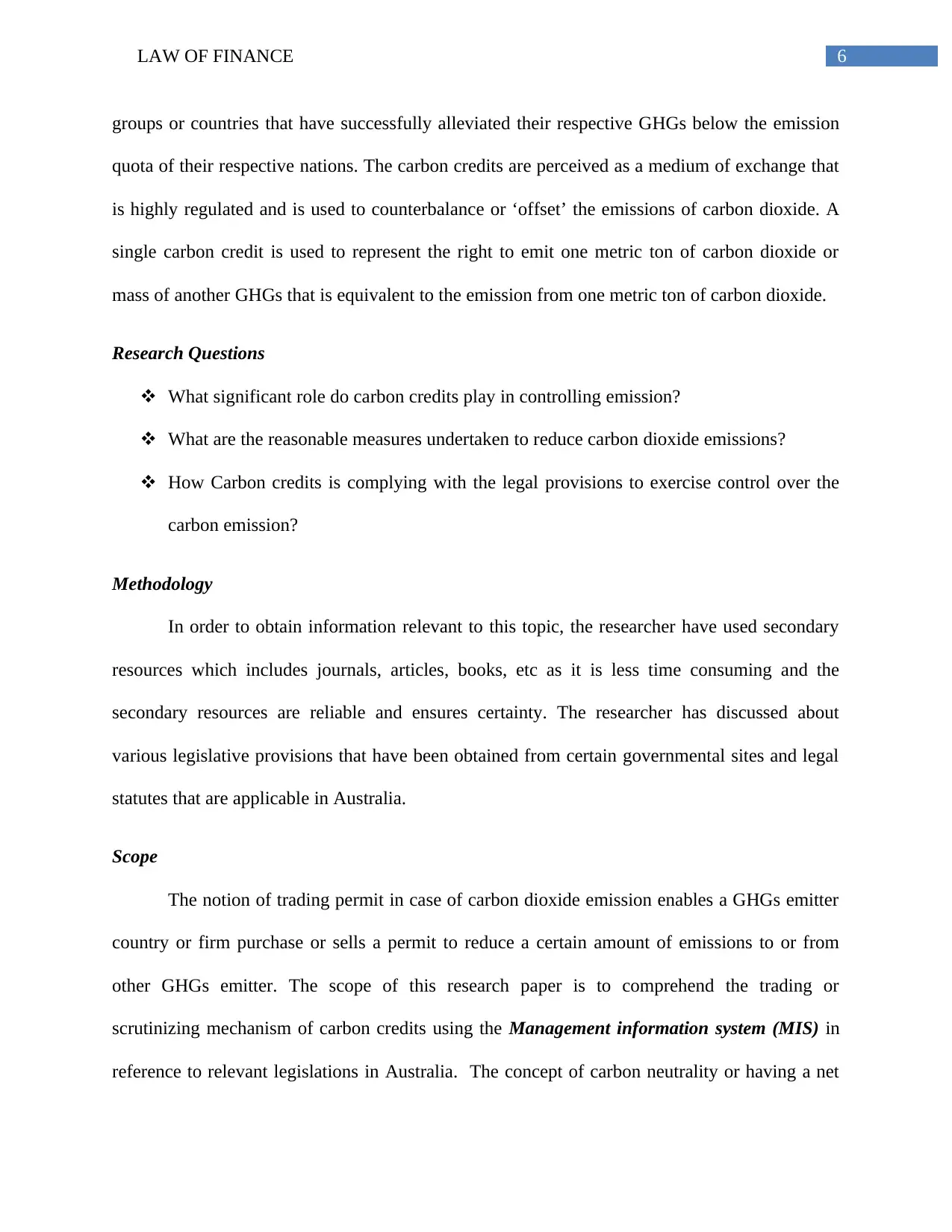
6LAW OF FINANCE
groups or countries that have successfully alleviated their respective GHGs below the emission
quota of their respective nations. The carbon credits are perceived as a medium of exchange that
is highly regulated and is used to counterbalance or ‘offset’ the emissions of carbon dioxide. A
single carbon credit is used to represent the right to emit one metric ton of carbon dioxide or
mass of another GHGs that is equivalent to the emission from one metric ton of carbon dioxide.
Research Questions
What significant role do carbon credits play in controlling emission?
What are the reasonable measures undertaken to reduce carbon dioxide emissions?
How Carbon credits is complying with the legal provisions to exercise control over the
carbon emission?
Methodology
In order to obtain information relevant to this topic, the researcher have used secondary
resources which includes journals, articles, books, etc as it is less time consuming and the
secondary resources are reliable and ensures certainty. The researcher has discussed about
various legislative provisions that have been obtained from certain governmental sites and legal
statutes that are applicable in Australia.
Scope
The notion of trading permit in case of carbon dioxide emission enables a GHGs emitter
country or firm purchase or sells a permit to reduce a certain amount of emissions to or from
other GHGs emitter. The scope of this research paper is to comprehend the trading or
scrutinizing mechanism of carbon credits using the Management information system (MIS) in
reference to relevant legislations in Australia. The concept of carbon neutrality or having a net
groups or countries that have successfully alleviated their respective GHGs below the emission
quota of their respective nations. The carbon credits are perceived as a medium of exchange that
is highly regulated and is used to counterbalance or ‘offset’ the emissions of carbon dioxide. A
single carbon credit is used to represent the right to emit one metric ton of carbon dioxide or
mass of another GHGs that is equivalent to the emission from one metric ton of carbon dioxide.
Research Questions
What significant role do carbon credits play in controlling emission?
What are the reasonable measures undertaken to reduce carbon dioxide emissions?
How Carbon credits is complying with the legal provisions to exercise control over the
carbon emission?
Methodology
In order to obtain information relevant to this topic, the researcher have used secondary
resources which includes journals, articles, books, etc as it is less time consuming and the
secondary resources are reliable and ensures certainty. The researcher has discussed about
various legislative provisions that have been obtained from certain governmental sites and legal
statutes that are applicable in Australia.
Scope
The notion of trading permit in case of carbon dioxide emission enables a GHGs emitter
country or firm purchase or sells a permit to reduce a certain amount of emissions to or from
other GHGs emitter. The scope of this research paper is to comprehend the trading or
scrutinizing mechanism of carbon credits using the Management information system (MIS) in
reference to relevant legislations in Australia. The concept of carbon neutrality or having a net
Paraphrase This Document
Need a fresh take? Get an instant paraphrase of this document with our AI Paraphraser
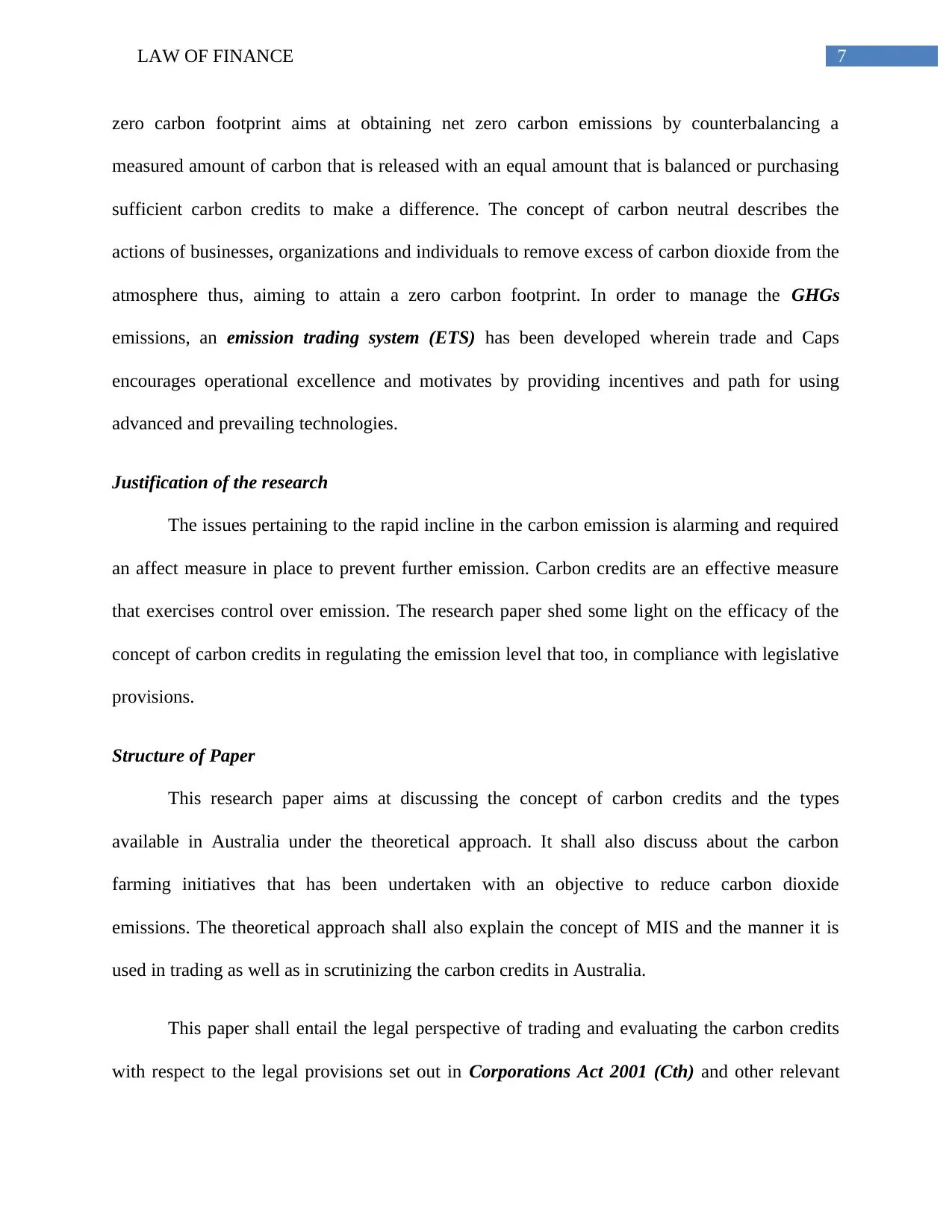
7LAW OF FINANCE
zero carbon footprint aims at obtaining net zero carbon emissions by counterbalancing a
measured amount of carbon that is released with an equal amount that is balanced or purchasing
sufficient carbon credits to make a difference. The concept of carbon neutral describes the
actions of businesses, organizations and individuals to remove excess of carbon dioxide from the
atmosphere thus, aiming to attain a zero carbon footprint. In order to manage the GHGs
emissions, an emission trading system (ETS) has been developed wherein trade and Caps
encourages operational excellence and motivates by providing incentives and path for using
advanced and prevailing technologies.
Justification of the research
The issues pertaining to the rapid incline in the carbon emission is alarming and required
an affect measure in place to prevent further emission. Carbon credits are an effective measure
that exercises control over emission. The research paper shed some light on the efficacy of the
concept of carbon credits in regulating the emission level that too, in compliance with legislative
provisions.
Structure of Paper
This research paper aims at discussing the concept of carbon credits and the types
available in Australia under the theoretical approach. It shall also discuss about the carbon
farming initiatives that has been undertaken with an objective to reduce carbon dioxide
emissions. The theoretical approach shall also explain the concept of MIS and the manner it is
used in trading as well as in scrutinizing the carbon credits in Australia.
This paper shall entail the legal perspective of trading and evaluating the carbon credits
with respect to the legal provisions set out in Corporations Act 2001 (Cth) and other relevant
zero carbon footprint aims at obtaining net zero carbon emissions by counterbalancing a
measured amount of carbon that is released with an equal amount that is balanced or purchasing
sufficient carbon credits to make a difference. The concept of carbon neutral describes the
actions of businesses, organizations and individuals to remove excess of carbon dioxide from the
atmosphere thus, aiming to attain a zero carbon footprint. In order to manage the GHGs
emissions, an emission trading system (ETS) has been developed wherein trade and Caps
encourages operational excellence and motivates by providing incentives and path for using
advanced and prevailing technologies.
Justification of the research
The issues pertaining to the rapid incline in the carbon emission is alarming and required
an affect measure in place to prevent further emission. Carbon credits are an effective measure
that exercises control over emission. The research paper shed some light on the efficacy of the
concept of carbon credits in regulating the emission level that too, in compliance with legislative
provisions.
Structure of Paper
This research paper aims at discussing the concept of carbon credits and the types
available in Australia under the theoretical approach. It shall also discuss about the carbon
farming initiatives that has been undertaken with an objective to reduce carbon dioxide
emissions. The theoretical approach shall also explain the concept of MIS and the manner it is
used in trading as well as in scrutinizing the carbon credits in Australia.
This paper shall entail the legal perspective of trading and evaluating the carbon credits
with respect to the legal provisions set out in Corporations Act 2001 (Cth) and other relevant
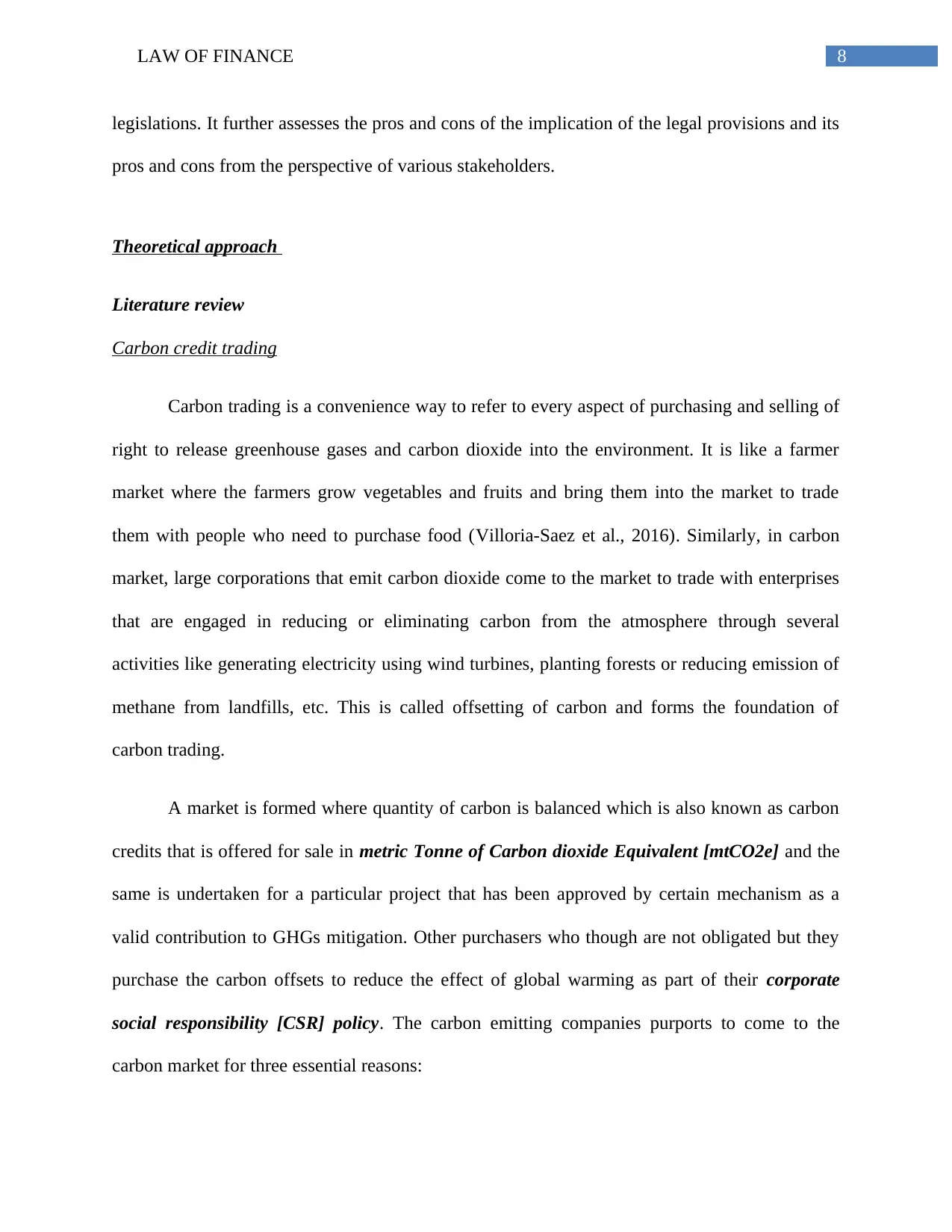
8LAW OF FINANCE
legislations. It further assesses the pros and cons of the implication of the legal provisions and its
pros and cons from the perspective of various stakeholders.
Theoretical approach
Literature review
Carbon credit trading
Carbon trading is a convenience way to refer to every aspect of purchasing and selling of
right to release greenhouse gases and carbon dioxide into the environment. It is like a farmer
market where the farmers grow vegetables and fruits and bring them into the market to trade
them with people who need to purchase food (Villoria-Saez et al., 2016). Similarly, in carbon
market, large corporations that emit carbon dioxide come to the market to trade with enterprises
that are engaged in reducing or eliminating carbon from the atmosphere through several
activities like generating electricity using wind turbines, planting forests or reducing emission of
methane from landfills, etc. This is called offsetting of carbon and forms the foundation of
carbon trading.
A market is formed where quantity of carbon is balanced which is also known as carbon
credits that is offered for sale in metric Tonne of Carbon dioxide Equivalent [mtCO2e] and the
same is undertaken for a particular project that has been approved by certain mechanism as a
valid contribution to GHGs mitigation. Other purchasers who though are not obligated but they
purchase the carbon offsets to reduce the effect of global warming as part of their corporate
social responsibility [CSR] policy. The carbon emitting companies purports to come to the
carbon market for three essential reasons:
legislations. It further assesses the pros and cons of the implication of the legal provisions and its
pros and cons from the perspective of various stakeholders.
Theoretical approach
Literature review
Carbon credit trading
Carbon trading is a convenience way to refer to every aspect of purchasing and selling of
right to release greenhouse gases and carbon dioxide into the environment. It is like a farmer
market where the farmers grow vegetables and fruits and bring them into the market to trade
them with people who need to purchase food (Villoria-Saez et al., 2016). Similarly, in carbon
market, large corporations that emit carbon dioxide come to the market to trade with enterprises
that are engaged in reducing or eliminating carbon from the atmosphere through several
activities like generating electricity using wind turbines, planting forests or reducing emission of
methane from landfills, etc. This is called offsetting of carbon and forms the foundation of
carbon trading.
A market is formed where quantity of carbon is balanced which is also known as carbon
credits that is offered for sale in metric Tonne of Carbon dioxide Equivalent [mtCO2e] and the
same is undertaken for a particular project that has been approved by certain mechanism as a
valid contribution to GHGs mitigation. Other purchasers who though are not obligated but they
purchase the carbon offsets to reduce the effect of global warming as part of their corporate
social responsibility [CSR] policy. The carbon emitting companies purports to come to the
carbon market for three essential reasons:
⊘ This is a preview!⊘
Do you want full access?
Subscribe today to unlock all pages.

Trusted by 1+ million students worldwide
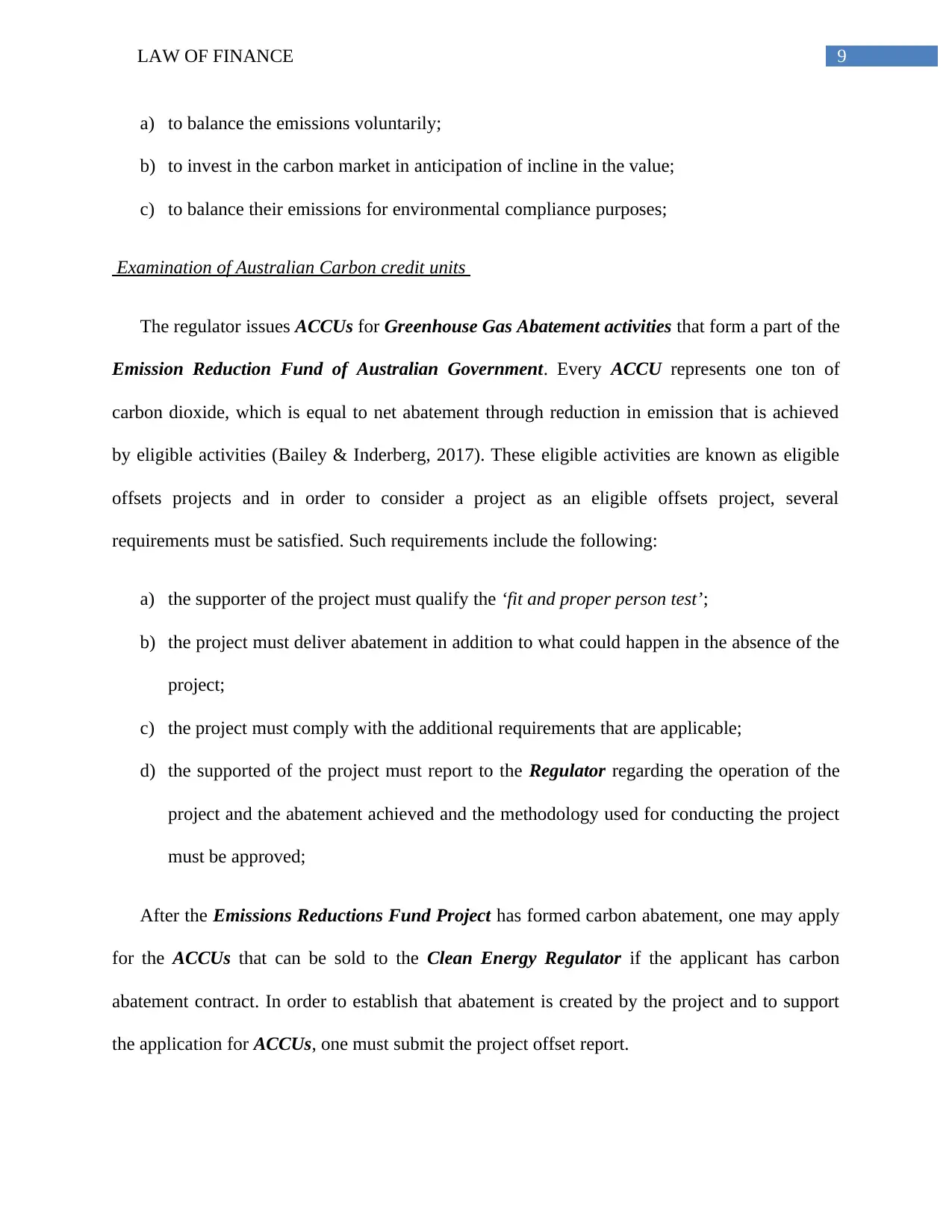
9LAW OF FINANCE
a) to balance the emissions voluntarily;
b) to invest in the carbon market in anticipation of incline in the value;
c) to balance their emissions for environmental compliance purposes;
Examination of Australian Carbon credit units
The regulator issues ACCUs for Greenhouse Gas Abatement activities that form a part of the
Emission Reduction Fund of Australian Government. Every ACCU represents one ton of
carbon dioxide, which is equal to net abatement through reduction in emission that is achieved
by eligible activities (Bailey & Inderberg, 2017). These eligible activities are known as eligible
offsets projects and in order to consider a project as an eligible offsets project, several
requirements must be satisfied. Such requirements include the following:
a) the supporter of the project must qualify the ‘fit and proper person test’;
b) the project must deliver abatement in addition to what could happen in the absence of the
project;
c) the project must comply with the additional requirements that are applicable;
d) the supported of the project must report to the Regulator regarding the operation of the
project and the abatement achieved and the methodology used for conducting the project
must be approved;
After the Emissions Reductions Fund Project has formed carbon abatement, one may apply
for the ACCUs that can be sold to the Clean Energy Regulator if the applicant has carbon
abatement contract. In order to establish that abatement is created by the project and to support
the application for ACCUs, one must submit the project offset report.
a) to balance the emissions voluntarily;
b) to invest in the carbon market in anticipation of incline in the value;
c) to balance their emissions for environmental compliance purposes;
Examination of Australian Carbon credit units
The regulator issues ACCUs for Greenhouse Gas Abatement activities that form a part of the
Emission Reduction Fund of Australian Government. Every ACCU represents one ton of
carbon dioxide, which is equal to net abatement through reduction in emission that is achieved
by eligible activities (Bailey & Inderberg, 2017). These eligible activities are known as eligible
offsets projects and in order to consider a project as an eligible offsets project, several
requirements must be satisfied. Such requirements include the following:
a) the supporter of the project must qualify the ‘fit and proper person test’;
b) the project must deliver abatement in addition to what could happen in the absence of the
project;
c) the project must comply with the additional requirements that are applicable;
d) the supported of the project must report to the Regulator regarding the operation of the
project and the abatement achieved and the methodology used for conducting the project
must be approved;
After the Emissions Reductions Fund Project has formed carbon abatement, one may apply
for the ACCUs that can be sold to the Clean Energy Regulator if the applicant has carbon
abatement contract. In order to establish that abatement is created by the project and to support
the application for ACCUs, one must submit the project offset report.
Paraphrase This Document
Need a fresh take? Get an instant paraphrase of this document with our AI Paraphraser
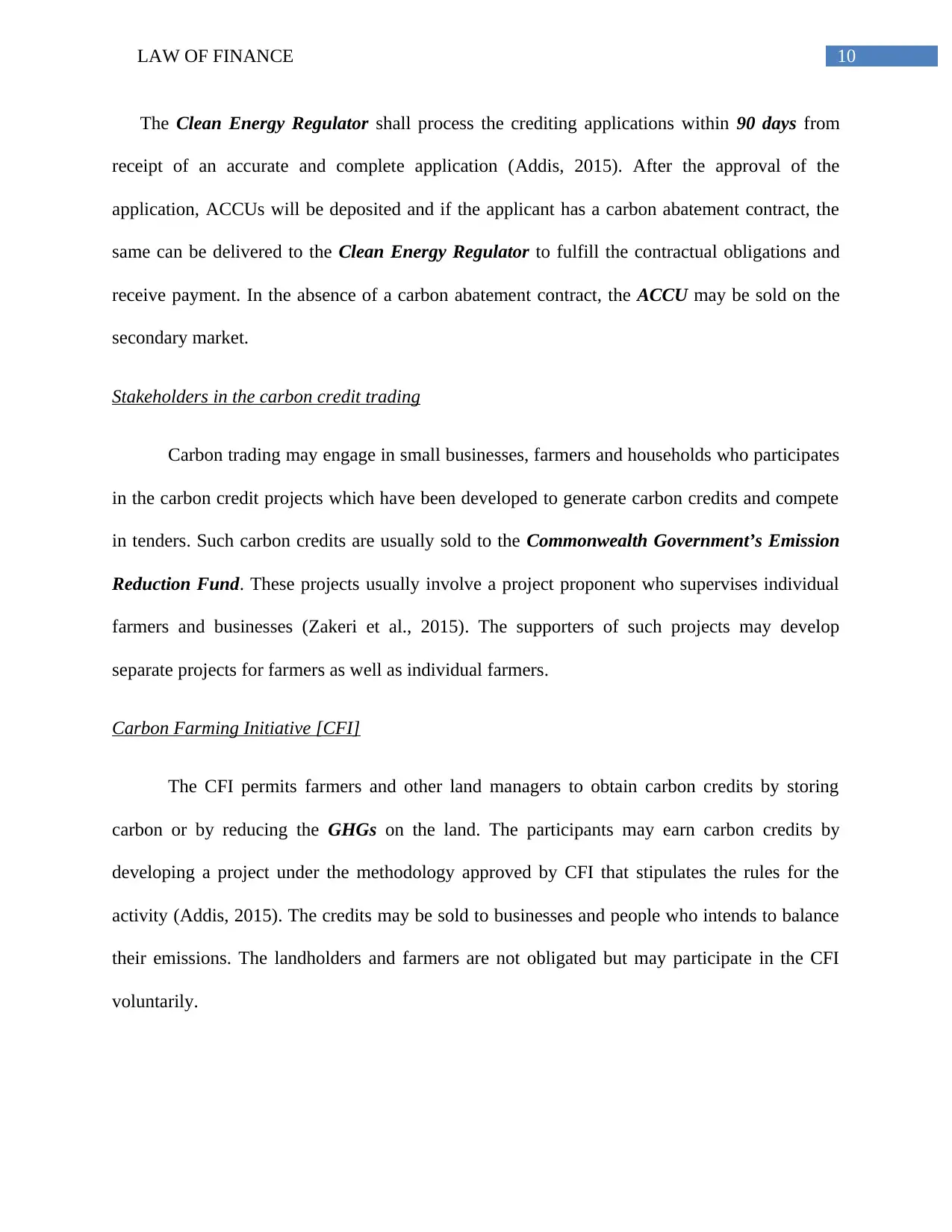
10LAW OF FINANCE
The Clean Energy Regulator shall process the crediting applications within 90 days from
receipt of an accurate and complete application (Addis, 2015). After the approval of the
application, ACCUs will be deposited and if the applicant has a carbon abatement contract, the
same can be delivered to the Clean Energy Regulator to fulfill the contractual obligations and
receive payment. In the absence of a carbon abatement contract, the ACCU may be sold on the
secondary market.
Stakeholders in the carbon credit trading
Carbon trading may engage in small businesses, farmers and households who participates
in the carbon credit projects which have been developed to generate carbon credits and compete
in tenders. Such carbon credits are usually sold to the Commonwealth Government’s Emission
Reduction Fund. These projects usually involve a project proponent who supervises individual
farmers and businesses (Zakeri et al., 2015). The supporters of such projects may develop
separate projects for farmers as well as individual farmers.
Carbon Farming Initiative [CFI]
The CFI permits farmers and other land managers to obtain carbon credits by storing
carbon or by reducing the GHGs on the land. The participants may earn carbon credits by
developing a project under the methodology approved by CFI that stipulates the rules for the
activity (Addis, 2015). The credits may be sold to businesses and people who intends to balance
their emissions. The landholders and farmers are not obligated but may participate in the CFI
voluntarily.
The Clean Energy Regulator shall process the crediting applications within 90 days from
receipt of an accurate and complete application (Addis, 2015). After the approval of the
application, ACCUs will be deposited and if the applicant has a carbon abatement contract, the
same can be delivered to the Clean Energy Regulator to fulfill the contractual obligations and
receive payment. In the absence of a carbon abatement contract, the ACCU may be sold on the
secondary market.
Stakeholders in the carbon credit trading
Carbon trading may engage in small businesses, farmers and households who participates
in the carbon credit projects which have been developed to generate carbon credits and compete
in tenders. Such carbon credits are usually sold to the Commonwealth Government’s Emission
Reduction Fund. These projects usually involve a project proponent who supervises individual
farmers and businesses (Zakeri et al., 2015). The supporters of such projects may develop
separate projects for farmers as well as individual farmers.
Carbon Farming Initiative [CFI]
The CFI permits farmers and other land managers to obtain carbon credits by storing
carbon or by reducing the GHGs on the land. The participants may earn carbon credits by
developing a project under the methodology approved by CFI that stipulates the rules for the
activity (Addis, 2015). The credits may be sold to businesses and people who intends to balance
their emissions. The landholders and farmers are not obligated but may participate in the CFI
voluntarily.
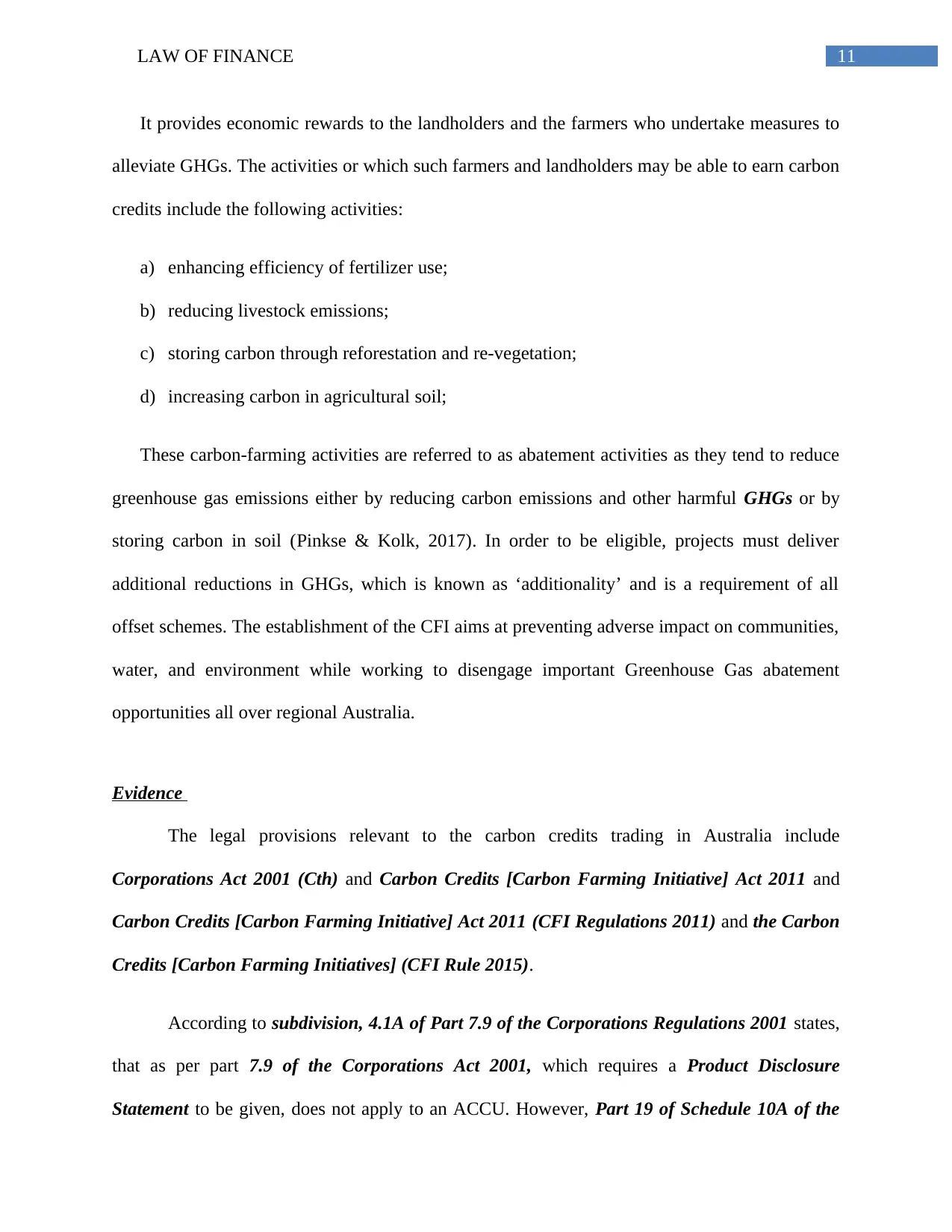
11LAW OF FINANCE
It provides economic rewards to the landholders and the farmers who undertake measures to
alleviate GHGs. The activities or which such farmers and landholders may be able to earn carbon
credits include the following activities:
a) enhancing efficiency of fertilizer use;
b) reducing livestock emissions;
c) storing carbon through reforestation and re-vegetation;
d) increasing carbon in agricultural soil;
These carbon-farming activities are referred to as abatement activities as they tend to reduce
greenhouse gas emissions either by reducing carbon emissions and other harmful GHGs or by
storing carbon in soil (Pinkse & Kolk, 2017). In order to be eligible, projects must deliver
additional reductions in GHGs, which is known as ‘additionality’ and is a requirement of all
offset schemes. The establishment of the CFI aims at preventing adverse impact on communities,
water, and environment while working to disengage important Greenhouse Gas abatement
opportunities all over regional Australia.
Evidence
The legal provisions relevant to the carbon credits trading in Australia include
Corporations Act 2001 (Cth) and Carbon Credits [Carbon Farming Initiative] Act 2011 and
Carbon Credits [Carbon Farming Initiative] Act 2011 (CFI Regulations 2011) and the Carbon
Credits [Carbon Farming Initiatives] (CFI Rule 2015).
According to subdivision, 4.1A of Part 7.9 of the Corporations Regulations 2001 states,
that as per part 7.9 of the Corporations Act 2001, which requires a Product Disclosure
Statement to be given, does not apply to an ACCU. However, Part 19 of Schedule 10A of the
It provides economic rewards to the landholders and the farmers who undertake measures to
alleviate GHGs. The activities or which such farmers and landholders may be able to earn carbon
credits include the following activities:
a) enhancing efficiency of fertilizer use;
b) reducing livestock emissions;
c) storing carbon through reforestation and re-vegetation;
d) increasing carbon in agricultural soil;
These carbon-farming activities are referred to as abatement activities as they tend to reduce
greenhouse gas emissions either by reducing carbon emissions and other harmful GHGs or by
storing carbon in soil (Pinkse & Kolk, 2017). In order to be eligible, projects must deliver
additional reductions in GHGs, which is known as ‘additionality’ and is a requirement of all
offset schemes. The establishment of the CFI aims at preventing adverse impact on communities,
water, and environment while working to disengage important Greenhouse Gas abatement
opportunities all over regional Australia.
Evidence
The legal provisions relevant to the carbon credits trading in Australia include
Corporations Act 2001 (Cth) and Carbon Credits [Carbon Farming Initiative] Act 2011 and
Carbon Credits [Carbon Farming Initiative] Act 2011 (CFI Regulations 2011) and the Carbon
Credits [Carbon Farming Initiatives] (CFI Rule 2015).
According to subdivision, 4.1A of Part 7.9 of the Corporations Regulations 2001 states,
that as per part 7.9 of the Corporations Act 2001, which requires a Product Disclosure
Statement to be given, does not apply to an ACCU. However, Part 19 of Schedule 10A of the
⊘ This is a preview!⊘
Do you want full access?
Subscribe today to unlock all pages.

Trusted by 1+ million students worldwide
1 out of 20
Related Documents
Your All-in-One AI-Powered Toolkit for Academic Success.
+13062052269
info@desklib.com
Available 24*7 on WhatsApp / Email
![[object Object]](/_next/static/media/star-bottom.7253800d.svg)
Unlock your academic potential
Copyright © 2020–2025 A2Z Services. All Rights Reserved. Developed and managed by ZUCOL.





